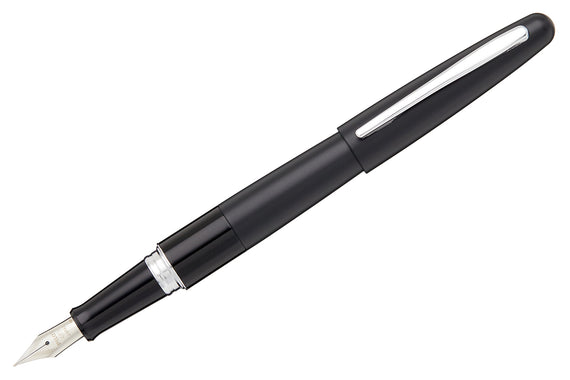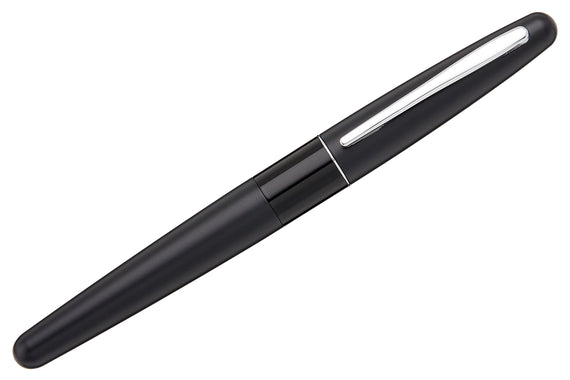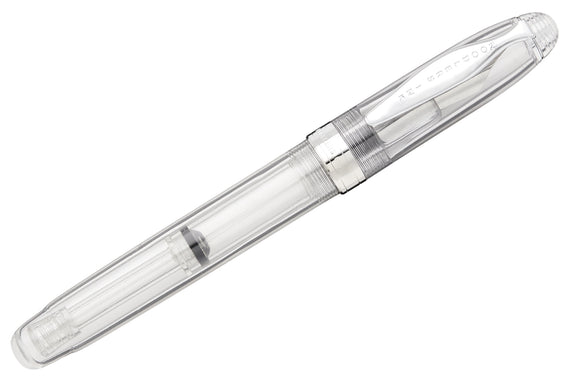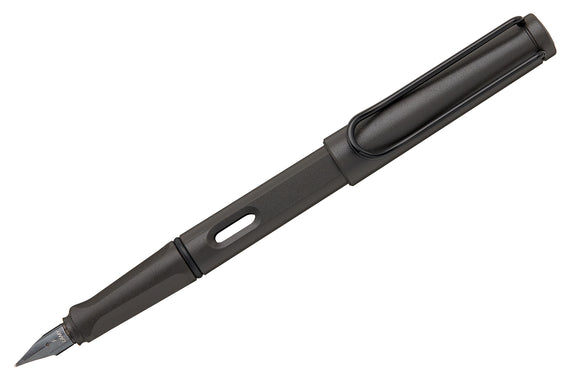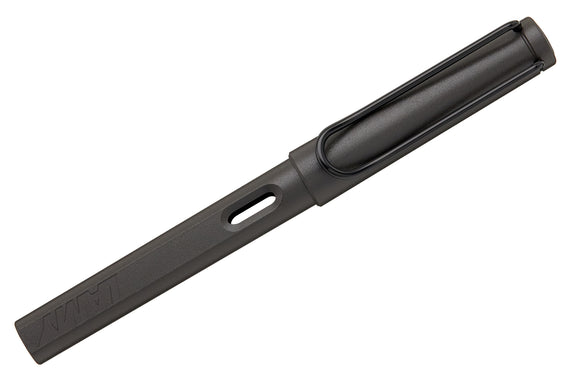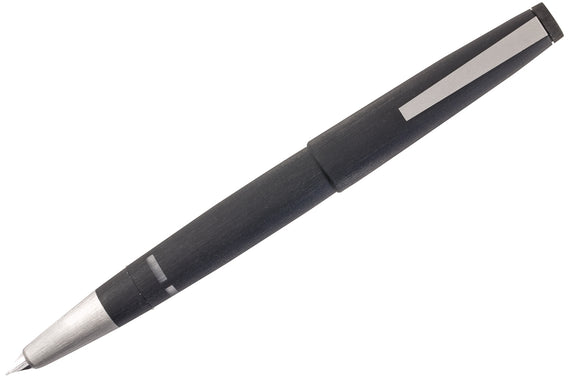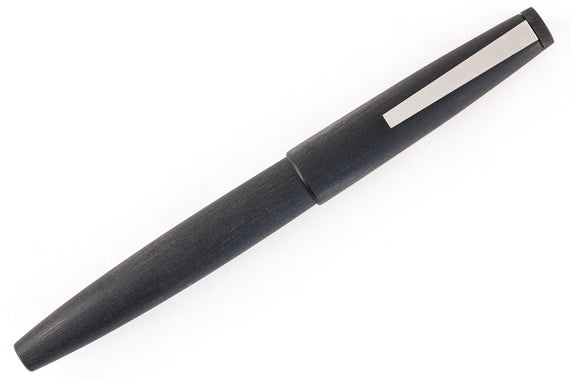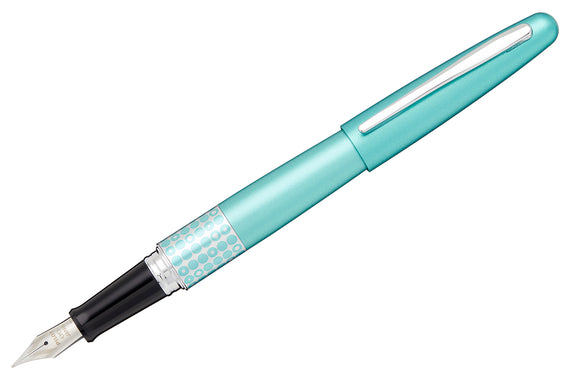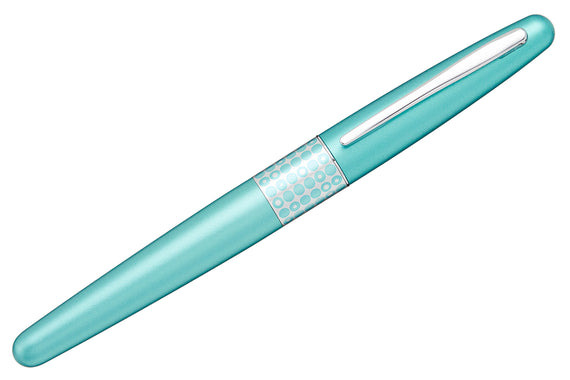Fountain Pen Nibs Explained
Fountain Pen 101: Part Four
Welcome to the Goulet Pens Fountain Pen 101 series where you can get all the basics down for learning about how to use fountain pens. We’re building upon the foundation set in the first three Fountain Pen 101 videos where we’ve covered what a fountain pen is, the parts that make up a fountain pens, and how to clean and maintain them. Here I’ll be going over the single most important part of a fountain pen when it comes to your writing experience... the nib.
Nibs can both look and perform differently from one pen to another. They can be fairly basic and utilitarian, almost hidden away unnoticeable, or they can be large, prominent and ornate to really stand out. For the purpose of this video, know that when I talk about nib size I’m referring to size of the line width that will show on paper, like fine or broad, not the physical overall size of the entire nib.
Like any hobby, you’re going to notice more of the nuanced differences in fountain pen nibs as your knowledge and experience grows, so I won’t cover everything here. But I’ll at least cover the basics so you know what’s most important to pay attention to as you learn about fountain pens.

What does a nib do?
The nib is the crucial element that delivers the ink to the paper and influences what your writing will actually look like on the page. The reason the nib is so important is because it’s the part of the pen that actually touches the writing surface. It’ll determines the feel of the pen as you write, it affects how thin or thick your line width, and it impacts how much ink flows to the paper. It’s doing a lot of important jobs at once.
Nibs can look pretty different from one pen to another, and there are a few types you might find out there. The classic fountain pen nib probably is recognizable to you, as this is what’s often shown in pop culture references with fountain pens. You’ll see the entire nib and feed exposed from the grip in their full glory.

Pens can also have hooded nibs, where the nib and feed are mostly covered by the grip of the pen. The advantage of this design is that the ink stays wetter on the nib, and you can grip closer down to the nib without getting ink on your fingers. While retractable refills are extremely common in ballpoint and rollerball pens, the mechanics of a fountain pen make this more of an engineering feat. But there are a couple of retractable nib pens out there, that have many of the benefits of the hooded nib.

There are also pens with inlaid nibs, which integrate the nib more into the body of the pen. These are mainly for aesthetics, but they look pretty cool.
Parts of a nib
Whatever style of nib you see, there’s a similar format to their design in order for them to bring ink to the page. Let’s cover the basic parts of a nib that are helpful to understand.
The body of the nib is what fits into the pen and holds it in place, though it’s often hidden inside the grip. The “face” usually has the company logo, may designate the material it’s made of, and will usually show the nib size, which is a helpful reference.
There’s a cut in the nib called the “slit” which is where the ink travels as it flows to the tip. On many nibs there’s a hole at the end of the slit called the “breather hole”, but it’s not going to be there on every pen as it’s mainly aesthetic.
The two halves of the nib created by the slit are called the “tines”, and those are precisely adjusted to be aligned with each other so the nib feels smooth as it glides across the page.
And that brings us to the tip or “tipping material” of the nib. This is the most crucial part of the nib. The tipping material is made of a hard-wearing alloy including precious metals like rhodium. This offers maximum durability since the tip is what will be making contact with paper for years and years. The tip is welded on and ground down to a specific “nib grind or nib size” that will determine the line width you end up with as you write. When you see a nib size designation on a nib, it’s referring to the size and shape of that tipping material.

Common nib sizes
When you’re using different fountain pens you’ll notice there are some common nib sizes that’ll give you thinner or thicker line widths. There are some principles that are helpful to keep in mind no matter which nib you use.
There’s always a tradeoff with nibs, and no one nib is right for everyone. It’ll be a highly personal choice, and it’s sometimes hard to know what you’re going to like until you experience it for yourself. I encourage you to try out as many different nibs as possible, to get an idea what you like. If you have any friends or family with fountain pens, try out all of theirs, otherwise try out less expensive pens in various grinds so you get a sense of what’s best for you.
The smaller the nib size, the thinner the line it puts down. Finer nibs put less ink on the paper, so it’ll smear less and dry faster. This is especially helpful if ink smearing is an issue such as left-handed writers who might move their hand over their writing. Finer nibs are also better for small handwriting, and writing on paper with smaller ruling such as 5mm dot grid.
On the flipside, finer nibs won’t feel as smooth as you write, since they have a smaller surface area on the tip. The fact they put down less ink means you won’t see special ink properties as well. Broader nibs, on the other hand, are great for showing special ink properties and they usually feel smoother. But you can run into issues with ink spreading out, absorbing through the paper, smearing, or taking longer to dry. Whether you prefer finer or broader nib sizes will honestly come down entirely to your preferences and how you like to write, and your preferences can certainly change over time, too.

Some of the most popular nib sizes you’ll see available on modern fountain pens include extra-fine, fine, medium and broad, which are all shaped with a round ball tip.
Extra-Fine
Extra-fine is a good nib size to consider if you’re newer to fountain pens, especially if you’re writing on really absorbent paper like ink jet printer paper or legal pads. These nibs are ideal if you write small, or enjoy small ruling like 5mm dot grid. If you want a smoother writing feel, you may want to go broader, especially if you write with a heavier hand. Extra-fine nibs need a lighter touch. If you like writing with a 0.38 Ultra-fine Pilot G2, you’ll like this size.
Fine
Fine nibs are what I like to recommend as the go-to nib size for everyday writing. You get a lot of the benefits of the extra fine, but it often feels noticeably smoother on the page than extra fines. This is often the most popular nib size for fountain pens we sell, across most brands. It’s just a good all-around size. If you like writing with a 0.5 extra-fine Pilot G2, you’ll like fine nibs.
Medium
Medium nibs are a bit broader than fine nibs, and start to get a bit thicker and wetter writing which will show off ink properties better than fines and extra fines. If you’re writing on 7mm college ruled paper, medium nibs still fit but it may start to feel a little crowded, going to 8mm standard ruling feels roomier. Mediums are a size I really like for when I have inks that have high sheen, shimmer, or shading properties, as I think it shows off the writing aspects that are most unique to fountain pens while still being pretty universal on most types of paper. If you write larger, have a heavier hand, or want to really see your ink, mediums are good for you. If you like writing with a 0.7 Fine Pilot G2, you’ll like medium nibs.
Broad
Broad nibs are some of my favorites because they’re going to feel the smoothest and put down the most ink of all the standard sizes. They’re not nearly as popular as the finer nib sizes though, as they start to feel crowded on smaller paper rulings. If you have absorbent paper it’ll put down a pretty wet line, and you have more of a risk of bleedthrough where the ink soaks through. However, when you have a beautiful ink and you can use high-quality ink-resistant paper, it’s going to look and feel amazing when you use broad nibs.
Stub/Italic
Stub nibs, sometimes called italic nibs, are sort of a different beast. Instead of being shaped to a round ball at the tip, they’re ground flat across the bottom. This results in an irregular line width that’s thinner on the cross stroke and thicker on the down stroke. It gives your writing a bit of a calligraphic effect, sort of like a gothic script. Stub nibs can come in a variety of sizes including some that are absolutely massive, but the most popular and most usable for everyday writing will be a 1.0mm or 1.1mm which is usually the standard in most brands.
Because the tip isn’t round, it means stubs are more sensitive to rotation in your hand so you have to sort of get used to writing with them. But when you do, it can make your handwriting look more impressive without having to really do anything different with your writing.

Now there are a NUMBER of other specialty nib sizes beyond the five I’ve mentioned here, but they start to get a bit specific and aren’t regularly available in most brands. Some fountain pen manufacturers feature more specialized grinds and have wide offerings unique to them, but the ones I’ve mentioned so far are the ones more universally available.
Japanese vs Western Nibs
Nib sizes are somewhat of a standard, but there’s also a lot of hand craftsmanship involved in shaping the tipping of a nib and each manufacturer may do it a little differently. So while you may generally prefer extra fine nibs, you may find with certain brands you actually prefer a fine nib because the way that company makes their fine is closer to the extra fine of another brand. It’s a little confusing, sort of like women’s clothing but not quite that variable.
One of the most noticeable differences you may find is with extra-fine and fine nibs. These sizes of nibs from Japanese manufacturers like Pilot, Sailor, and Platinum are often ground finer than those from Western manufacturers based in Germany, Italy, France, and the UK. Most of the reason for this is because it’s more of a standard nib size offering in Japan to have a medium-fine, or sometimes called fine-medium, while that’s not very common with Western pen brands. So in order to make room for the medium-fine, the fine and extra-fine are made a bit thinner... thus the variance across brands.
If you’re looking at mediums, broads, and stubs though, they’re more of a standard size across all brands.

One extremely helpful tool we’ve developed at Goulet Pens is something we call the Nib Nook, which shows scans of writing samples I’ve personally done with every nib size from every model of every brand of pen we carry. You can compare them to each other, or reference a nib you already have and compare it to something else you’re interested in. It’s a great way to see the actual line widths, standardized to the same ink, paper, and person writing.

Nib Materials
Fountain pen nibs have a hard job. They need to hold up to years of use, withstand prolonged contact with ink, and have just the right properties of stiffness and flexibility so they’re durable and feel good in your hand. Over the many decades fountain pens have been around, pen companies have tried darn near everything out there for making nibs. The two materials that have stood the test of time and dominate all modern pens are stainless steel and gold.

Stainless Steel
Stainless steel nibs in recent years are really quite good, and are more economical. They’re often stiffer feeling than gold nibs, but they’re reliable, durable, and can write every bit as smoothly as gold nibs if the attention is given to them at the manufacturer. Stainless steel nibs are the standard these days for fountain pens. Because it’s the standard, you often won’t see any designation for steel on the nib face, it’s just assumed. However, the nib itself can be made of steel but plated in gold or another finish so it looks a different color, but it’ll write exactly the same as a regular steel nib.

Gold
The other alternative is gold nibs, and these can come in different levels of gold purity. 14k gold and 18k gold are the most common, with 21k gold even being offered by Sailor. The main advantage to gold nibs over stainless steel is that gold is softer. If two nibs are of the same design, the gold nib will write with a bit of bounce to it, acting a little bit like the shock absorber on your car that just helps for a smoother ride. A steel and gold nib can both have the same tipping smoothness but the gold might just “feel” a little smoother because of the softness of the metal. All gold nibs are yellow gold, so when a silver aesthetic is desired they’re often plated in rhodium. You can usually tell nibs are made of gold because they’ll often designate it on the face of the nib with the carat rating of the gold.
That said, gold nibs come at a price since gold is significantly more expensive than steel. You’ll often pay an additional $150 or more for a fountain pen just for that gold nib. There is a certain panache with gold nibs so you’ll see them offer more by default on pens costing hundreds of dollars or more. Some pens are offered with both steel and gold nib options at different price points, but usually, it’ll be one or the other based on the pen model. However, gold nibs are certainly not a requirement, and just because a nib is made of gold doesn’t inherently mean it’s better or that you’ll like it more. If you’re just starting out, stick with stainless steel nibs until you get more experience and can even tell the difference in the feel.

Important terms to cover with nibs:
The last thing I wanted to cover is some terminology around nibs and how they perform that’ll be helpful for you as you learn writing with different pens, and discuss them with others.
Feedback, tooth, or toothiness all describe how the nib feels on the page as you write. If it glides across the paper it’s really smooth, but if you feel some drag as you write, that’s feedback or tooth. This feeling will vary depending how the manufacturer smooths the nib, the paper you write with, your writing pressure, and a number of other factors. Each person has their own preference, too.
Scratchy nibs are when there’s something wrong and it’s actually digging into the paper. It could be a misaligned tine, a nib that’s been overflexed and now the tines won’t come back together, or some other physical issue that’s off. No nibs should be scratchy, and if it is you’ll want to contact where you got it or consider getting it repaired or serviced.
Flow refers to the viscosity of the ink through the nib. A dry-writing pen will put down less ink so the color will be weaker and you’ll feel more feedback. A wet-writing pen will gush ink out, look darker and take longer to dry. While the flow of a pen varies by pen model and even nib size, you’ll also find that ink itself will have different flow, so you can fine tune your flow by trying different inks in different pens, too.
Bounce refers to the stiffness of a nib, if you press on it will it bend at all. It might also be called spring.
Flex nibs are made so that when you write with light pressure the tines stay together and you get the line width of the tipping size. But the tines of the nib are made to bend under pressure, so you can widen your line width as you press down, and thin your line as you lighten the pressure. It adds a whole other dimension to your writing which can be a lot of fun, but I will say it’s not the easiest thing to get into if you’re new to fountain pens. It introduces a number of additional variables and I think it’s best to wait to try flex nibs until you have a solid understanding of fountain pens and you feel comfortable troubleshooting various issues with ink flow.
Soft nibs are somewhere in between regular stiff nibs and flex nibs. Most soft nibs can bend a little for a bouncier writing feel, but don’t necessarily provide you any variance in line width as you add pressure. Other soft nibs will provide some line variation, but it should be used sparingly like for your signature…if you flex them hard on a regular basis you could end up wearing the nib out and needing to repair it.

Summary
There’s SO much more nuance to fountain pen nibs. Part of the joy of the fountain pen journey is getting to experience different nibs, pens, ink and paper. Taking what you’ve learned in this video you’re going to be in a lot better shape than I was when I first started out, and I hope you feel empowered to try some different nibs and see what you like for yourself.
Feel free to reach out to us with any questions you have, and do check out these additional links with lots of other information about these magnificent writing instruments. Write on!
Additional Resources:
- Fountain Pen 101 part 1: What is a Fountain Pen?
- Fountain Pen 101 part 2: How Do Fountain Pens Work?
- Fountain Pen 101 part 3: How to Clean a Fountain Pen
- Fountain Pen 101 part 5: How to Write with a Fountain Pen
- Flex Nib Fountain Pens
- How to Write with a Stub Nib
- Japanese vs Western Nibs
- Nib Nook Comparison Tool

